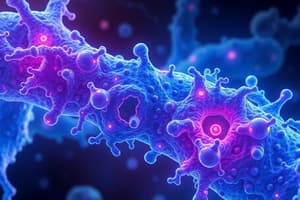Podcast
Questions and Answers
What is the main function of the APC/C complex in cells?
What is the main function of the APC/C complex in cells?
- Activates target proteins for cellular processes
- Properly localizes proteins within the cell
- Inactivates target proteins for cellular processes
- Catalyzes the degradation of proteins triggering chromosome separation (correct)
Which enzyme is essential for the attachment of SUMO to other proteins?
Which enzyme is essential for the attachment of SUMO to other proteins?
- E1 (correct)
- E3
- E2
- HECT ligase
What is the main difference between ubiquitination and sumoylation?
What is the main difference between ubiquitination and sumoylation?
- Ubiquitination forms chains, while sumoylation does not.
- SUMO activates target proteins for cellular processes.
- Ubiquitin requires E1, E2, and E3 enzymes, while SUMO does not.
- Ubiquitin always tags proteins for degradation, while SUMO does not. (correct)
Which type of polyubiquitin chain can activate or inactivate a target protein?
Which type of polyubiquitin chain can activate or inactivate a target protein?
What is the role of E3 ligase in the ubiquitination process?
What is the role of E3 ligase in the ubiquitination process?
Which type of ligases form part of a complex with multiple subunits and possess the RING domain?
Which type of ligases form part of a complex with multiple subunits and possess the RING domain?
What is the first step in the ubiquitination process?
What is the first step in the ubiquitination process?
What is the critical role of lysines in the ubiquitin protein?
What is the critical role of lysines in the ubiquitin protein?
What is the function of the Ubiquitin Conjugating Enzyme (E2) in the ubiquitination process?
What is the function of the Ubiquitin Conjugating Enzyme (E2) in the ubiquitination process?
What distinguishes RING type E3 enzymes from HECT type E3 enzymes?
What distinguishes RING type E3 enzymes from HECT type E3 enzymes?
How does E3 enzyme contribute to specificity in the ubiquitination system?
How does E3 enzyme contribute to specificity in the ubiquitination system?
What is a characteristic feature of HECT ligases?
What is a characteristic feature of HECT ligases?
What is the post-translational modification process that tags proteins for degradation?
What is the post-translational modification process that tags proteins for degradation?
Which organelle is filled with plenty of hydrolytic enzymes and has an acidic pH of 4.5?
Which organelle is filled with plenty of hydrolytic enzymes and has an acidic pH of 4.5?
What is the large complex responsible for degrading proteins, consisting of more than 50 subunits?
What is the large complex responsible for degrading proteins, consisting of more than 50 subunits?
Which enzyme type is responsible for transferring ubiquitin to a target protein during the ubiquitination process?
Which enzyme type is responsible for transferring ubiquitin to a target protein during the ubiquitination process?
Which enzyme is involved in activating ubiquitin before it is transferred to the target protein during ubiquitination?
Which enzyme is involved in activating ubiquitin before it is transferred to the target protein during ubiquitination?
Which type of E3 enzyme directly interacts with both the target protein and the E2 enzyme during ubiquitination?
Which type of E3 enzyme directly interacts with both the target protein and the E2 enzyme during ubiquitination?
Study Notes
Ubiquitination and Sumoylation
- The main function of the APC/C complex is to regulate the cell cycle by degrading specific proteins.
- SUMO (Small Ubiquitin-like MOdifier) is attached to other proteins by the enzyme E1 (Activating Enzyme).
- The main difference between ubiquitination and sumoylation is that ubiquitination typically targets proteins for degradation, whereas sumoylation can have various effects on protein function, such as localization, interaction, and activity.
Ubiquitination Process
- The type of polyubiquitin chain that can activate or inactivate a target protein is K63-linked polyubiquitin chain.
- E3 ligase plays a crucial role in the ubiquitination process by recognizing specific target proteins and facilitating the transfer of ubiquitin.
- RING-type E3 ligases form part of a complex with multiple subunits and possess the RING domain.
- The first step in the ubiquitination process is the activation of ubiquitin by the enzyme E1 (Activating Enzyme).
- Lysines in the ubiquitin protein are critical for the formation of polyubiquitin chains.
- The Ubiquitin Conjugating Enzyme (E2) plays a key role in the ubiquitination process by transferring activated ubiquitin to the target protein.
- RING-type E3 enzymes differ from HECT-type E3 enzymes in that they do not form a covalent intermediate with ubiquitin.
- E3 enzymes contribute to specificity in the ubiquitination system by recognizing specific target proteins and facilitating the transfer of ubiquitin.
- A characteristic feature of HECT ligases is that they form a covalent intermediate with ubiquitin.
Protein Degradation
- The post-translational modification process that tags proteins for degradation is ubiquitination.
- The lysosome is the organelle filled with plenty of hydrolytic enzymes and has an acidic pH of 4.5.
- The proteasome is the large complex responsible for degrading proteins, consisting of more than 50 subunits.
- The Ubiquitin-Protein Ligase (E3) is responsible for transferring ubiquitin to a target protein during the ubiquitination process.
- The Ubiquitin-Activating Enzyme (E1) is involved in activating ubiquitin before it is transferred to the target protein during ubiquitination.
- RING-type E3 enzymes directly interact with both the target protein and the E2 enzyme during ubiquitination.
Studying That Suits You
Use AI to generate personalized quizzes and flashcards to suit your learning preferences.
Related Documents
Description
Test your knowledge on the recognition of proteins by the proteasome and the process of ubiquitination. Learn about the role of polyubiquitin chains and the specific lysines involved in these processes.



